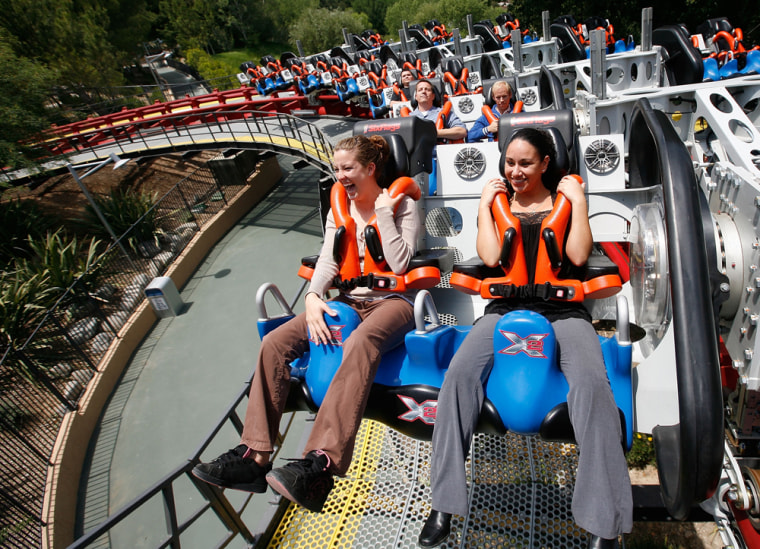Matthew Lambert is on a mission. Making the 40-minute drive between his home in West Knoxville, Tenn., and the Dollywood theme park in Pigeon Forge a couple times a month, he needs to notch a few more rides on Thunderhead, the park’s 100-foot-high, 55-mph roller coaster.
“I’m at 1,991 times,” he said. “I’ve got nine to go to make 2,000.”
In fact, by the time you read this, he may very well be starting down the track toward the big 3-0-0-0.
Coaster yogis and crazy ACEers
Clearly, hardcore roller coaster enthusiasts are not your average theme park visitors. Many travel extensively, trying to ride as many different coasters as they can, while others, like Lambert, find a favorite that fits the bill for habitual thrills. “We’re like amusement park groupies,” joked Robb Alvey, owner/creator of ThemeParkReview.com. “We’re all a little screwed up.”
And they’re in good company, with conventions, ERT (Exclusive Ride Time) events and online forums where the thrill factor of thousands of rides are reviewed, analyzed and endlessly debated. The world’s largest ride enthusiast organization, American Coaster Enthusiasts (ACE), has approximately 7,000 members.
“We call them crazy ACErs or coaster yogis,” said Chris Gray, a designer for Great Coasters International Inc., the company that built Thunderhead. “They know the layout of rides like the back of their hand.”
Even so, the thrill is still there, according to Lambert, who once rode Thunderhead 103 times in a single day. “Even knowing what’s going on and what’s going to happen, it’s different every time. You feel like you have absolutely no control over anything that’s going on around you.”
For Frank Farley, a psychologist at Temple University, the typical coaster yogi is a classic “Big T” personality, i.e., someone who craves novelty, intensity and excitement. (The “T” is for thrill, with “little t” types preferring routine and risk-averse activities.) “Roller coasters provide a whole smorgasbord of stimulation,” Farley said. “Rapid breathing, elevated heart rate — there’s a Niagara of changes going on in the brain.”
“What you’re doing is preparing to die,” said Margaret J. King, director of Cultural Studies & Analysis, a Philadelphia think tank. Not literally, of course — roller coasters are incredibly safe — but in terms of how our bodies naturally react to stressful situations. “Your body is basically screaming at you to get out of there.”
Which, of course, you can’t once the lap bar comes down. That, in turn, underscores the loss of control, as do the high-speed spins, sudden changes of direction and other disorienting moves. Suddenly, the biochemicals start flowing (you’re aroused, hyper-aware); your digestive system goes on hold (one reason many people get queasy) and everyone around you is screaming at the top of their lungs (another alarm cue, King noted).
“It’s a classic ‘fight or flight’ response,” she said. “We’re taught to respond that way because that’s the way it worked when we were Cro-Magnons living on the savannah.”
Fear – death = thrill
Of course, your average Cro-Magnon couldn’t get off his daily Stone Age thrill ride and go get a beer or bag of popcorn. And while most coaster enthusiasts focus on the ride itself, it’s really what happens when people get off that prompts them to get back on.
“You’ve faced down death and survived, and your body responds by flooding you with biochemicals,” King said. “Adrenaline, serotonin, oxytocin — you feel triumph, relief, a bond with the people you’ve ridden with. It’s all very sexy.”
And ride designers are masters at engendering those effects by maximizing the disorienting elements of their creations. Thunderhead, for example, features a “station fly-through” in which trains come screaming through the loading area at 40 mph right behind and above people just as they’re about to board. “It’s loud; the whole station’s shaking, and then the lap bar comes down,” Gray said. “It’s like, Boom! You have absolutely no time to prepare for what’s coming.”
Other rides use other elements to keep riders off-balance. At Six Flags Magic Mountain, for example, X2 features dangling seats that rotate horizontally 360 degrees so riders are often upside down and backwards. (Big T types can’t get enough of it; little t types should probably keep on walking.) As a result, even repeat riders still get a rush no matter how many times they ride.
Jodi Malone, for example, has ridden X2 1,082 times (and counting). In fact, she likes the ride so much she has a 10-inch tattoo of it on her upper arm and is currently working on a book about women and roller coasters. It’s called “Screaming Orgasms: Men of Wood & Steel” and, as the name suggests, chronicles a lifetime of “encounters, flings and affairs” with X2 and a host of other coasters.
Which, come to think of it, may explain how people can ride the same coaster repeatedly without becoming so familiar with it that it loses its appeal. “In a sense it’s like sex,” said Farley of Temple University. “People have sex over and over and over again, but it’s still a thrill.”
